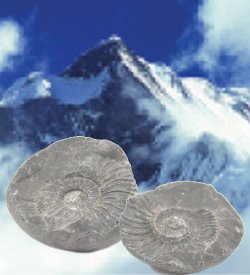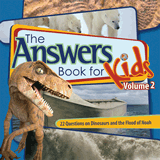Kids Feedback: Did Noah and His Family Require Oxygen as the Flood Covered the Mountains?
My 10 year old son, Grant, stumped his parents this week when discussing the great flood during his daily homeschool Bible lesson. If the flood covered the entire earth and the highest mountains, wouldn’t Noah and his family have required oxygen at that altitude?
– T.M., South Carolina

Fossil ammonites (coiled marine cephalopods) like this one are found in limestone beds high in the Himalayas of Nepal. How did marine fossils get thousands of feet above sea level?
Thanks for sending in your son’s question! Noah and his family would not have required oxygen due to high altitudes during the Flood, because the pre-Flood earth did not have high-altitude mountains such as we find on the earth today. The catastrophic nature of the Flood produced major geological changes on the earth’s surface. That is why marine fossils and marine limestone beds are found in some mountain ranges—a place where we certainly wouldn’t expect to find them!
“So how did these marine limestone beds get high up in the Himalayas? We must remember that the rock layers in the Himalayas and other mountain ranges around the globe were deposited during the Flood, well before these mountains were formed. In fact, many of these mountain ranges were pushed up by earth movements to their present high elevations at the end of the Flood. This is recorded in Psalm 104:8, where the Flood waters are described as eroding and retreating down valleys as the mountains rose at the end of the Flood. ”1
– Dr. Andrew Snelling
Furthermore, atmospheric air pressure is relative to sea level. So as rising sea levels pushed the air column higher, the air pressure at sea level would stay basically the same. We must remember that for the duration of the Flood, Noah and his family aboard the Ark were at “sea level.”
To learn more about Noah’s Flood and its geological effects on the earth, please see the following:
- Noah's Ark
- Fossils
- I Really, Really, Really Want Answers About Noah!
- The Answers Book for Kids: Volume 2
- Kids Feedback: When God Made Dry Land, Was It Like Pangea?
- How God Saved Noah
Parents, if your children have any questions, please submit them using the “contact us” section on our main website.
Footnotes
- Andrew Snelling, “High & Dry Sea Creatures,” Answers Magazine, v3 n1, http://www.answersingenesis.org/articles/am/v3/n1/high-dry-sea-creatures.
Recommended Resources
- © 2024 Answers in Genesis
- Privacy Policy
- Contact
- About



